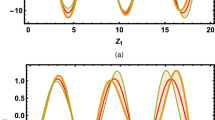Abstract
Based on the improved ADI method, this article proposes an improved implicit finite difference scheme for solving 3-D shallow water flows. The main objective is to design a numerical relation between the horizontal velocity on each layer and the depth-averaged velocity for employing the improved ADI method. With the free surface elevation and the depth-averaged velocity obtained by using essentially 2-D depth-averaged mode, the velocity profiles can be obtained easily and simultaneously. The wind-induced flows, the open channel flows due to the pressure gradient and the tidal flows in coastal waters are simulated, and the results are consistent well with the analytical solution and the field data, which shows that the present implicit scheme is stable and effective, and the established model is practical. Moreover, when only one vertical layer is specified, the present 3-D numerical model is reducea to the 2-D depth-averaged model.
Similar content being viewed by others
References
HAM D. A., PIETRZAK J. and STELLING G. S. A scalable unstructured grid 3-dimensional finite volume model for the shallow water equations[J]. Ocean Modelling, 2005, 10(1): 153–169.
HUANG Sui-liang, JIA Y. F. and WANG SAM S. Y. Numerical modeliing of suspended sediment transport in channel bends[J]. Journal of Hydrodynamics, Ser. B, 2006, 18(4): 411–417.
LU Qi-ling, ZHENG Bang-min and ZHAO Ming-deng et al. Three-dimensional numerical simulations on the scour funnel in front of the sand-flash channel for reservoir[J]. Journal of Hydrodynamics, Ser. A, 2007, 22(2): 484–491(in Chinese).
ZHANG Ming-liang, SHEN Yong-ming. Threedimensional simulation of meandering river based on 3-D turbulence model[J]. Journal of Hydrodynamics, 2008, 20(4): 448–455.
CUI Zhan-feng, ZHANG Xiao-feng and FENG Xiaoxiang. Numerical simulation on scour around spuredike by 3D turbulent model[J]. Chinese Journal of Hydrodynamics, 2008, 23(1): 33–41(in Chinese).
CASULLI V., STELLING G. S. Simulation of threedimensional, non-hydrostatic free-surface flows for estuaries and coastal seas, in: Estuarine and coastal modeling[C]. Proceedings of the 4th International Conference. New York, 1995, 1–11.
YANG L. W., OZER J. An ADI technique for solving three-dimensional coastal circulation[J]. Acta Oceanologica Sinica, 1997, 16(3): 281–302.
LIN B., FALCONER R. A. Tidal flow and transport modelling using the ultimate quickest scheme[J]. Journal of Hydraulic Engineering, ASCE, 1997, 123(4): 303–314.
BORTHWICK A. G. L., AKPONASA G. A. Reservoir flow prediction by contravariant shallow water equations[J]. Journal of Hydraulic Engineering, ASCE, 1997, 123(5): 432–439.
SONG Zhi-yao, XUE Hong-chao and YAN Yi-xin et al. Quasi-3D numerical simulation of tidal hydrodynamic field[J]. China Ocean Engineering, 1999, 13(3): 265–276.
HUA Zu-lin, XING Ling-hang and Gu Li. Application of a modified quick scheme to depth-averaged k-e turbulnce model based on unstructured grids[J]. Journal of Hydrodynamics, 2008, 20(4): 514–523.
ABBOTT M. B. Computational hydraulic[M]. Boston, Mass: Pitman Advanced Publishing Program, 1980.
MAA J. P. Y. An efficient horizontal two-dimensional hydrodynamic model[J]. Coastal Engineering, 1990, 14(1): 1–18.
SHI Feng-yan, KONG Ya-zhen and DING Ping-xing. Numerical tidal current modeling using fine boundary-fitted grids for tidal flats[J]. China Ocean Engineering, 1998, 16(3): 68–75.
PHILLIPS N. A. A coordinate system having some special advantages for numerical forecasting[J]. J. Meteorol., 1957, 14: 184–208.
GARRAT J. R. Review of drag coefficients over oceans and continents[J]. Monthly Weather Review, 1977, 105: 915–929.
OFFICER C. B. Physical oceanography of estuaries and associated coastal waters[M]. New York: Wiley, 1976.
DRAGO M., IOVENITTI L. s-coordinates hydrodynamic numerical model for coastal and ocean three-dimensional circulation[J]. Ocean Engineering, 2000, 27(10): 1065–1085.
PIETRZAK J., JAKOBSON J. B. A three-dimensional hydrostatic model for coastal and ocean modeling using a generalized topography following co-ordinate system[J]. Ocean Modelling, 2002, 4(2): 173–205.
ZHANG Dong-sheng. Mtidal wave in the Yellow Sea Radiate shoal region[J]. Journal of Hohai University, 1996, 24(5): 35–40(in Chinese).
MELLOR G. L., YAMADA T. Development of a turbulence closure model for geophysical fluid problems[J]. Rev. Geophys. Space Phys., 1982, 20(4): 851–875.
Author information
Authors and Affiliations
Corresponding author
Additional information
Project supported by the National Natural Science Foundation of China (Grant No. 40730527), the Public Fund Project from Ministry of Water Resources (Grant No.200701026) and the Open Fund of State Key Laboratory of Resource and Environment Information System, Hohai University, (Grant No. 2007491211).
Biography: ZHANG Zhuo (1981-), Male, Ph. D. Candidate
Rights and permissions
About this article
Cite this article
Zhang, Z., Song, Zy. & Lv, Gn. A New Implicit Scheme for Solving 3-D Shallow Water Flows. J Hydrodyn 21, 790–798 (2009). https://doi.org/10.1016/S1001-6058(08)60214-0
Received:
Revised:
Published:
Issue Date:
DOI: https://doi.org/10.1016/S1001-6058(08)60214-0




